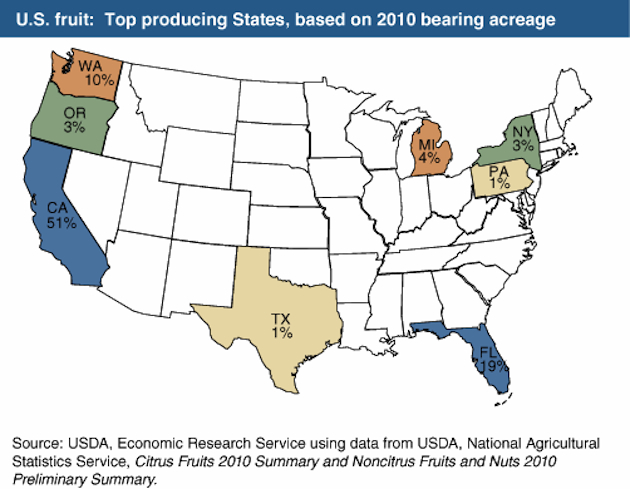Indeed, plus the further North you go the shorter the growing season is. Most of our produce comes from CA.
 https://www.motherjones.com/food/2015/04/decalifornify-cotton-vegetables-fruit-south/
https://www.motherjones.com/food/2015/04/decalifornify-cotton-vegetables-fruit-south/
California produces a sizable majority of many American fruits, vegetables, and nuts: 99 percent of artichokes, 99 percent of walnuts, 97 percent of kiwis, 97 percent of plums, 95 percent of celery, 95 percent of garlic, 89 percent of cauliflower, 71 percent of spinach, and 69 percent of carrots (and the list goes on and on). Some of this is due to climate and soil. No other state, or even a combination of states, can match California’s output per acre. Lemon yields in California, for example, are more than 50 percent higher than in Arizona. California spinach yield per acre is 60 percent higher than the national average. Without California, supply of all these products in the United States and abroad would dip, and in the first few years, a few might be nearly impossible to find http://www.slate.com/articles/health_and_science/explainer/2013/07/california_grows_all_of_our_fruits_and_vegetables_what_would_we_eat_without.html
[yet]
half our fruit is imported...Over the past two decades, the United States Department of Agriculture has issued roughly 100 new rules allowing specific crops to be imported from certain countries — like peppers from Peru. Crops that previously would have not been approved because they might introduce invasive pests and diseases were allowed in through new “systems approaches”..As a result, the proportion of the imported fresh fruit eaten in the United States rose to 53.1 percent in 2016, from 23 percent in 1975..
Of some concern is a 2015 report from the Food and Drug Administration that found that 9.4 percent of imported fruit samples violated federal standards for pesticide residues, compared with 2.2 percent of domestic samples...
Whatever the drawbacks or advantages, imports are likely to continue growing. According to a recent Agriculture Department report, fresh produce imports will rise 45 percent from 2016 to 2027, .  https://www.nytimes.com/2018/03/13/dining/fruit-vegetables-imports.html
https://www.nytimes.com/2018/03/13/dining/fruit-vegetables-imports.html